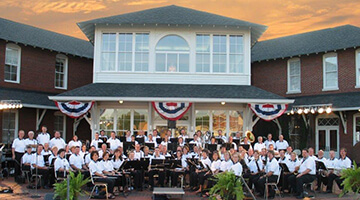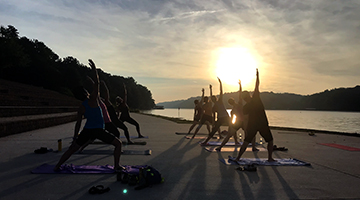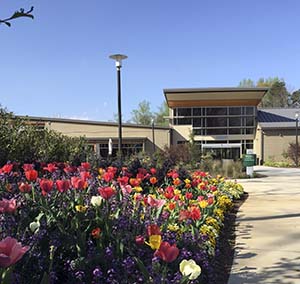
The garden features a 5,000 sq. ft. visitor’s center.
What was just a dream in the early years of the 21st century has become a world-class destination. Atlanta Botanical Garden Gainesville opened on May 15, 2015, after more than 10 years of planning, design and construction plus hundreds of thousands of hours of volunteer time to propagate an untold number of plants, trees and shrubs. All propagation was done by staff with volunteer assistance to grow the plants in the greenhouse and nursery.
In 2001, a donation by Charles and Lessie Smithgall of 182 wooded acres in north Hall County, including the family home, made it possible for what is now known as Atlanta Botanical Garden Gainesville.
Next month, the garden will celebrate its 10th anniversary. In those 24 short years between the gift of the property and today, it’s almost inconceivable how that vision has matured.
Mildred Fockele, ABG Gainesville’s director, has been there from the beginning. She was serving as the vice president of horticulture at the Atlanta Botanical Garden when the Smithgalls began to search for the right organization to care for the land in perpetuity.
“They decided that creating a large public woodland garden adjacent to the family home would be the right use of the property,” Fockele said. “We worked to help bring their vision to ABG Gainesville. At the time, Mrs. Smithgall told us, ‘We must not lose our connection to the land. If I could be on this land 50, 100 years from now, this is what I’d like to see … people enjoying the land. Because that’s what we did.’ ”
The board and staff of ABG began a long-term master plan that started with building a greenhouse and nursery in 2004.
“The goal was to have a place to propagate plants that would be the backbone of the garden,” she said. “There wasn’t enough room to do the necessary work in Atlanta, and so it made sense to build the greenhouse and nursery first.”
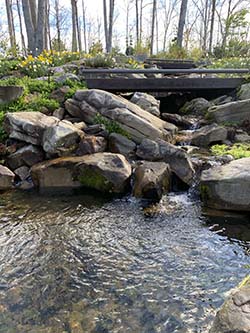
A stream flows through the main garden.
For the next 11 years, planning the 5,000-square-foot Visitors’ Center with reception area, event space, a gift shop and staff offices, designing the pathways and trails, creating water features, integrating the landscaping, and a 2,000-seat amphitheater continued almost non-stop.
“The only time work slowed was during the economic downturn in 2008/9, but once it had passed, work began in earnest. And remember, not only did our brick-and-mortar facilities come together, simultaneously we were carrying out the overall landscape and garden design.”
From paved pathways and flowing streams to planting the bones of the garden with new trees and shrubs – beneath the existing tree canopy – to determining how to add color, incorporating woody plant collections, creating a logical flow through the land and including an obvious sense of garden immersion, the project continues to expand.
“A children’s garden, our pollinator garden, the amphitheater, the expansion of our Visitors’ Center and our edible garden have come together not only for the enjoyment and education of our members and the public, but also to support diversity in the wildlife of the area.”
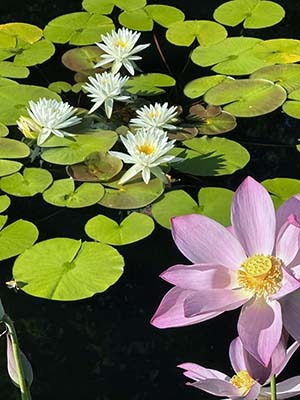
The pond’s water lilies are a popular summer attraction.
As members of the American Public Garden Association both the Atlanta Botanical Garden in Atlanta and Atlanta Botanical Garden Gainesville showcase a number of “collections” of significant plants. In Gainesville collections of hydrangeas, maples and magnolias are complemented by other collections around the country. “It’s invaluable to be able to expand our collections and develop others as the garden continues to mature.”
The Atlanta Botanical Garden’s Southeastern Center for Plant Conservation comprises both campuses. The Gainesville location is home to one of the Southeast’s largest conservation nurseries and serves as a genetic repository for plants used in re-establishment projects around the Southeast.
The Smithgall Home Place also plays an important role in the garden’s international work. The International Plant Exploration Program works in both northern Vietnam and northeastern India with other scientific organizations. Visiting scientists from Vietnam, India and other countries have stayed at the home place while in Georgia. Other original buildings on the property are used for offices, research and programming.
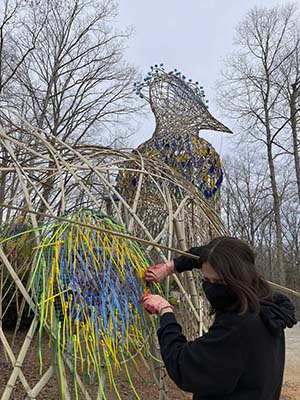
Exhibits, like this giant woven peacock installed in 2021, are regularly featured at the garden.
“These are the kinds of behind-the-scenes initiatives that the public doesn’t see,” she said. “But the work that’s being done internationally, and our part in it, are extremely important as we collaborate with organizations such as Vietnam Academy of Science and Technology and the Botanical Survey of India. We can train individuals in these countries in horticultural techniques that help them propagate and conserve their own threatened flora.
The Gainesville location hosts exhibitions every summer, some an extension of exhibits in Atlanta, and some uniquely theirs. Ribbit the Exhibit featured copper frog sculptures, plus LEGO Nature Connects, and nine Catrinas brought added interest to the summer season.
“Later this year, we will feature Forest Forms: Woodland Wonders, with metal sculptures of larger than life flowers and insects created by an Atlanta artist, and we are planning our own version of holiday lights,” she said.
The garden’s summer Fun Fest takes place on Saturday, June 7, and will include plant sales, crafts and music. A full schedule of events will include tours, classes and workshops.
The Atlanta Botanical Garden Gainesville is open Tuesday through Sunday from 9 a.m. to 5 p.m. from March through October, and 9 a.m. to 3 p.m. from November through February. For more information, visit Atlantabg.org/Gainesville or call 404 888-4760.
Photos: by Alan Hope

